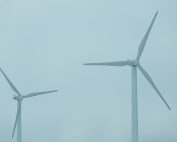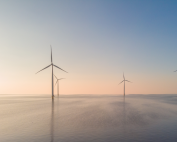Offshore wind energy will not develop without raw materials, technology, transmission lines or ports. The growth of offshore wind around the world is creating more and more opportunities for ship owners and operators to maximize profits and grow their business in this industry. Gregor Scott, Head of Havfram’s Business Acquisition segment, explains to us in Copenhagen the importance of designing vessels that are key to wind energy development.
As the offshore wind sector grows, so does the need for larger, more reliable and efficient vessels to build and operate wind projects. New wind turbine installation vessels (WTIVs), service vessels (CSOVs) and crew transfer vessels (CTVs) will be required, as will be upgraded to existing CSOVs, to serve the growing offshore wind market. Gregor Scott, Business Acquisition Director at Havfram said that designing the vessels is to ensure that they would be future proof.
“The size of turbines is growing significantly, as we’ve seen from the 8 MW turbines that are installed today, to the 12, 15, but they will come to 20 and beyond and their size. We don’t want to be in a position in a few years, time to be upgrading the vessels. We’ve started with a blank sheet of paper and said: What is the technology of the future? What size of a vessel will be required in 10 years’ time to be able to deliver efficient offshore solutions and installation capability? We’re building these vessels with a significant hook so that they will be able to take the 20 MW plus turbines, and carry them on deck, instead of on 5/6 on deck at any time, to be an efficient installation process”, says Scott.
He stressed that the green footprint that these vessels have is very important.
“We see that from certain markets already in Europe that there are limits being placed on the emissions for the complete wind farm development. We have implemented a number of technologies to try and minimize our carbon footprint for the boats. They will have battery packs fitted. Their peak loads are taken by the battery rather than a diesel generator. That means we can run with one generator less. Also, within the jacking system and the crane of the vessel we have energy recovery systems that will help to recharge the batteries. In addition, the main engines themselves will be capable of operating on low to zero emissions fuel going forward, as crucial for us in order to meet the aspirations and hopes of ourselves, and our customers”, Gregor Scott explained.
Havfram looks at the Baltic Sea
Havfram has two main regions that it’s focusing on as a business – the East Coast of America and Northwest Europe.
“If you look at the developments going forward for the build-out announced so far, the UK is a significant one. But we also look at Poland and the Baltic Sea. There’s massive potential there, and a massive number of projects. We see that as a crucial part of over or what we’re seeking to do. We want to be a part of the process there. We’ve done a lot of confirmation to ensure that we can get the vessels into the Baltic, it is not a straightforward process with the bridge that the tower. We have to be very careful with those. So we’ve made sure again with the design of the boats, we will be able to take these next-generation vessels in and build some wind farms there”, said Scott.















